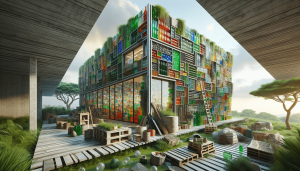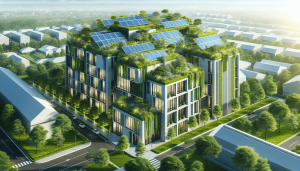Understanding Green Building Certification
In today’s world, sustainability is more important than ever, and understanding green building certification helps us take significant steps toward a healthier planet. Green building certification ensures that our constructions and renovations meet specific environmental standards, promoting energy efficiency, resource conservation, and overall sustainability. By adopting these practices, we contribute to a positive impact on our ecosystems and create healthier living spaces for ourselves and future generations. This article delves into what green building certification means, how it works, and why it’s crucial for our communities and the environment. Have you ever wondered what green building certification is and why it’s becoming increasingly prevalent in today’s construction industry? We’ve noticed that this concept often floats around in conversations about sustainability and eco-friendliness, but understanding its full scope can sometimes be elusive. Let’s dive into the world of green building certification and explore why it’s so impactful.

What is Green Building Certification?
Green building certification is an evaluation system that measures a building’s environmental performance and impact. It rewards structures that meet certain sustainability standards, promoting not just energy efficiency but also the conservation of resources and a reduced carbon footprint. Essentially, it’s a way for us to build smarter, healthier, and more efficient spaces for living and working.
Why is Green Building Certification Important?
Green building certification is crucial for multiple reasons. Firstly, it helps reduce the environmental impact of construction, which is traditionally quite resource-intensive. Secondly, certified buildings often offer better indoor air quality, leading to healthier occupants. Lastly, such certifications can also provide economic benefits through energy savings and increased property values.
Major Green Building Certification Systems
There are several green building certification systems globally, each with its unique criteria and focus areas. Let’s take a look at some of the most prominent ones:
LEED (Leadership in Energy and Environmental Design)
Developed by the U.S. Green Building Council (USGBC), LEED is perhaps the most recognizable green building certification worldwide. It covers a wide range of building types and focuses on sustainable site development, water savings, energy efficiency, materials selection, and indoor environmental quality.
| Certification Level | Points Required |
|---|---|
| Certified | 40-49 |
| Silver | 50-59 |
| Gold | 60-79 |
| Platinum | 80+ |
BREEAM (Building Research Establishment Environmental Assessment Method)
Originating from the UK, BREEAM is another major player in the green building certification arena. It assesses buildings for their environmental, social, and economic sustainability performance using standards developed through consultation with industry stakeholders.
| Rating | Score Range (%) |
|---|---|
| Pass | ≥ 30 |
| Good | ≥ 45 |
| Very Good | ≥ 55 |
| Excellent | ≥ 70 |
| Outstanding | ≥ 85 |
WELL Building Standard
The WELL Building Standard focuses on the health and well-being of building occupants. Its certification is based on performance across seven categories: air, water, nourishment, light, fitness, comfort, and mind.
| Certification Level | Points Required |
|---|---|
| Silver | Met preconditions |
| Gold | Met preconditions + 40% of optimizations |
| Platinum | Met preconditions + 80% of optimizations |
Green Star
Developed by the Green Building Council of Australia, Green Star rates the environmental impact of buildings and communities in Australia.
| Rating | Score Range |
|---|---|
| 4 Star | 45-59 |
| 5 Star | 60-74 |
| 6 Star | 75+ |
Key Components of Green Building Certifications
Each certification system has its unique criteria, but common elements overlap. Understanding these shared components can help us better grasp what constitutes a green building.
Sustainable Sites
This involves selecting and developing sites that minimize environmental impact. It includes considerations like reducing urban sprawl, protecting ecosystems, and using land responsibly.
Water Efficiency
Efficient water use is critical. This component typically measures how well the building conserves water, minimizes wastage, and protects water quality.
Energy and Atmosphere
Energy efficiency is central to green building certification. This aspect assesses the building’s energy use, reliance on renewable energy, and efforts to reduce greenhouse gas emissions.
Materials and Resources
Using sustainable materials with minimal environmental impact is another significant area. This includes the use of recycled, regional, and sustainably sourced materials and the implementation of waste reduction strategies.
Indoor Environmental Quality
This focuses on the quality of the indoor environment, including air quality, lighting, acoustics, and overall occupant well-being.
Innovation and Design Process
Innovation credits are awarded for exceptional performance above the standard requirements or for innovative practices. It encourages creative and effective solutions to sustainability challenges.
Benefits of Green Building Certification
Environmental Benefits
Green buildings substantially lower their environmental footprint. They use less energy and water, generate less waste, and often incorporate renewable energy sources.
Economic Benefits
Although green buildings can be more costly to build, they result in significant savings over time. Lower energy and water bills, higher property values, and incentives from governments can offset the initial investment.
Health and Well-being
Green buildings often provide healthier living and working environments. Improved air quality, natural lighting, and better overall comfort can lead to happier, more productive occupants.
Marketability and Prestige
Buildings with green certifications can attract tenants and buyers more easily. It’s a mark of quality and forward-thinking that can elevate a property’s market position.

Challenges in Achieving Green Building Certification
While the benefits are clear, achieving green building certification isn’t without its challenges. Understanding these can help us set realistic expectations and better navigate the certification process.
Costs
Initial costs for green building can be higher due to specialized materials and technologies. While these are offset by reduced operational costs, the upfront investment can be a barrier.
Complexity
The certification process can be complex and time-consuming. It requires meticulous planning, documentation, and adherence to specific criteria, which can be daunting for project teams.
Market Readiness
In some regions, the market for green materials and technologies may not be fully developed, making it more challenging to meet certification requirements.
The Future of Green Building Certification
The momentum behind green building is expected to grow as awareness of climate change and sustainability deepens. Here’s what we can expect to see in the future:
Stricter Standards
As technology advances and our understanding of environmental impact improves, certification standards are likely to become more stringent. This will drive innovation and further reduce the environmental footprint of new buildings.
Expanded Scope
Green building certification may expand to cover more aspects of sustainability, including social and economic impacts. Concepts like Life Cycle Analysis (LCA) and social sustainability could become more integral to certification criteria.
Increased Adoption
With growing awareness and evidence of the benefits, more building owners and developers are expected to seek certification. This trend can lead to a broader adoption of sustainable practices industry-wide.
Integrated Technologies
The integration of smart technologies is another future trend. Real-time monitoring systems, advanced energy management tools, and AI-driven solutions could enhance the performance and sustainability of certified buildings.
Global Harmonization
As green building certification systems evolve, there might be efforts to harmonize standards globally. This could simplify the process for multinational companies and ensure a consistent approach to sustainability worldwide.

How to Approach Green Building Certification
Taking the plunge into green building can be a bit overwhelming, but with a structured approach, we can navigate the certification process successfully.
Set Clear Goals
Begin by identifying the goals for your green building project. Whether it’s energy efficiency, water savings, or occupant health, having clear objectives can guide the planning and design process.
Engage Professionals
Consider engaging professionals who are experienced in green building projects. Architects, engineers, and consultants with expertise in sustainable design can help ensure your project meets certification criteria efficiently.
Conduct a Feasibility Study
Before diving in, conduct a feasibility study to understand the costs, benefits, and challenges of certifying your building. This can provide a clear picture of what to expect and how to plan for it.
Choose the Right Certification
Choose a certification system that aligns with your goals and project specifics. Whether LEED, BREEAM, WELL, Green Star, or another system, each has its strengths and focus areas.
Plan Thoroughly
Detailed planning is crucial. Make sure to integrate sustainable practices from the project’s inception to avoid costly changes later on. The earlier sustainability is incorporated, the easier and more cost-effective it is to achieve certification.
Monitor and Document
Throughout the construction process, monitor progress and maintain thorough documentation. This ensures all components meet the standards required for certification and helps in the final certification process.
Conclusion
Understanding green building certification allows us to appreciate its vital role in promoting sustainability, energy efficiency, and occupant well-being. These certifications provide a framework that encourages responsible resource use and innovative design solutions. While achieving certification can be challenging, the long-term benefits far outweigh the initial hurdles, offering environmental, economic, and social advantages.
As we continue to develop and construct our built environment, green building certification will increasingly become the norm rather than the exception. By embracing these standards, we can contribute to a healthier, more sustainable future for our planet.



